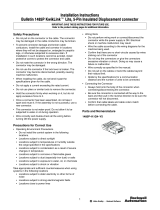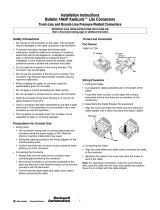Page is loading ...

1792D-5.49 - August 1999
Installation Instructions
ArmorBlock LP2 16 Sourcing
Output Module
(Cat. No. 1792D-OBT16LP)
This ArmorBlock LP2™ I/O module (Cat. No. 1792D-0BT16LP) is a
stand-alone 24V dc I/O product which communicates via a DeviceNet™
network. The sealed housing of this module requires no enclosure.
This model has 16 sourcing outputs accessed through Y splitter cables.
Outputs are self protected 24V dc and provide up to 0.3A each.
42049
O-4
O-5
O-6
O-7
O-11
O-10
O-2
O-3
O-13
O-12
O-9
O-8
Network Status
Module Status
O-0
O-1
O-15
O-14
Auxiliary Power

2 ArmorBlock LP2 16 Sourcing Output Module
1792D-5.49 - August 1999
Package Contents
Your package contains:
• 1 ArmorBlock LP2 Module
• Installation Instructions
European Union Directive Compliance
If this product has the CE mark it is approved for installation within the
European Union and EEA regions. It has been designed and tested to meet
the following directives.
EMC Directive
This product is tested to meet Council Directive 89/336/EC
Electromagnetic Compatibility (EMC) and the following standards, in
whole or in part, documented in a technical construction file:
• EN 50081-2 EMC - Generic Emission Standard, Part 2 - Industrial
Environment
• EN 50082-2 EMC - Generic Immunity Standard, Part 2 - Industrial
Environment
This product is intended for use in an industrial environment.
Low Voltage Directive
This product is tested to meet Council Directive 73/23/EEC Low Voltage,
by applying the safety requirements of EN 61131-2 Programmable
Controllers, Part 2 - Equipment Requirements and Tests.
For specific information required by EN 61131-2, see the appropriate
sections in this publication, as well as the following Allen-Bradley
publication Industrial Automation Wiring and Grounding Guidelines For
Noise Immunity, publication 1770-4.1.

ArmorBlock LP2 16 Sourcing Output Module 3
1792D-5.49 - August 1999
Install Your ArmorBlock LP2 I/O Module
To install the module:
• Mount the module and attach the unit to the DeviceNet trunk.
• Set the node address and baud rate.
• Connect the output cord sets to the LP2 module.
• Communicate with your ArmorBlock LP2 module.
More detailed information about each of these steps is in the following
procedures.
Mount the Module and Attach the Unit to the Devicenet Trunk
1. Mount the module using the dimensions shown below.
2. Connect the grey DeviceNet cable to the DeviceNet trunk. Use the
1485P-P1R5-MN5R1 T-Part tap to make the connection to round
media. Use the 1485P-P1E4-R5 to connect to the Kwik Link flat media
system.
3. Connect the black auxiliary power cable to your 24V dc power source.
Set the Node Address and Baud Rate
Set the node address using RSNetWorx for DeviceNet™ software,
DeviceNetManager™ software, or another software configuration tool. The
module is equipped with AutoBaud detect. AutoBaud lets the module read
the settings already in use on your DeviceNet network and automatically
adjusts to follow those settings.
O-4
O-5
O-6
O-7
O-11
O-10
O-2
O-3
O-13
O-12
O-9
O-8
Network Status
Module Status
O-0
O-1
O-15
O-14
Auxiliary Power
42049
4.21in
107mm
0.25in
6.25mm
12in
305mm
1.95in
49.5mm
6.85in
174mm
2.7in
68.5mm
(width)

4 ArmorBlock LP2 16 Sourcing Output Module
1792D-5.49 - August 1999
Connect the Output Cord Sets to the LP2 Module
This module uses 5 pole micro (12mm) style PCB mounted connectors.
Eight micro caps cover the connectors on your module. Remove the caps
and connect your cables to the appropriate ports. This product has two
outputs per connector. Use a “Y” splitter cable for access to all output
connections. For more information on these cables, see the Product Data
guide, publication 1792-2.1.
Use the micro caps to cover and seal unused ports. A pinout diagram for
the connectors is shown below.
!
ATTENTION:
• Make sure all connectors and caps are securely tightened
to properly seal the connections against leaks and
maintain IP67 requirements.
• For maximum noise immunity, output cable return wires
must be properly terminated. When outputs are
connected in loopback, return wires should be connected
together.
• I/O cable length should be less than 30 meters.
1
5
3
4
2
Output Micro-Connector
(View into Sockets)
Pin 1 Not Used
Pin 2 Output B
Pin 3 Auxiliary Power Return
Pin 4 Output A
Pin 5 Not Used
41452

ArmorBlock LP2 16 Sourcing Output Module 5
1792D-5.49 - August 1999
Output connectors for this module are shown below.
Communicate with Your ArmorBlock LP2 Module
This ArmorBlock module’s I/O is exchanged with the master through a
polled, change of state, or cyclic connection.
The module produces output data as follows:
Cyclic - allows configuration of the block as an I/O client. The block will
consume and produce its I/O cyclically at the rate configured.
Polled - a master initiates communication by sending its polled I/O
message to the module. The 16 output module consumes the message,
updates outputs, and producing a response. The response has output faults
and the status of the Auxiliary power.
Type of I/O Connections Consumes Produces
Cyclic 2 Bytes 1 Byte
Polled 2 Bytes 1 Byte
Change of State 2 Bytes 1 Byte
O-4
O-5
O-6
O-7
O-11
O-10
O-2
O-3
O-13
O-12
O-9
O-8
Network Status
Module Status
O-0
O-1
O-15
O-14
Auxiliary Power
42049
Output 0
Output 1
Output 2
Output 3
Output 4
Output 5
Output 6
Output 7
Output 15
Output 14
Output 13
Output 12
Output 11
Output 10
Output 9
Output 8
Connector A
Connector B
Connector C
Connector D
Connector H
Connector G
Connector F
Connector E

6 ArmorBlock LP2 16 Sourcing Output Module
1792D-5.49 - August 1999
Change of state -productions occur when an output changes or a fault
condition occurs. If no output or fault condition change occurs within the
expected packet rate, a heartbeat production occurs. This heartbeat
production tells the scanner module that the I/O module is alive and ready
to communicate. Consumption occurs when data changes and the master
produces new output data to the I/O block.
Refer to the table below for the word/bit definitions.
The DeviceNet Network uses advanced network technology, producer/
consumer communication, to increase network functionality and
throughput. Visit our website at http://www.ab.com/networks
for producer/
consumer technology information and updates.
Bit 0706050403020100
Produces 0 RSVD OPWR RSVD RSVD RSVD RSVD RSVD RSVD
Consumes 0 O7 O6 O5 O4 O3 O2 O1 O0
Consumes 1 O15 O14 O13 O12 O11 O10 O9 O8
Where: O = Output RSVD = Reserved OPWR = Output Power (Auxiliary Power)
Byte Bit Description
Produces 0 00-05
06
07
Reserved
OPWR = Output power fault, Auxiliary Power is not present
Reserved
Consumes 0 00-07 Output bits - when the bit is set (1), the output will be
turned on. Bit 00 corresponds to output 0, bit 01
corresponds to output 1, bit 02 to output 2, bit 03 to output
3, bit 04 to output 4, bit 05 to output 5, bit 06 to output 6,
and bit 07 to output 7
Consumes 2 08-07 Output bits - when the bit is set (1), the output will be
turned on. Bit 00 corresponds to output 8, bit 01
corresponds to output 9, bit 02 to output 10, bit 03 to
output 11, bit 04 to output 12, bit 05 to output 13, bit 06 to
output 14, and bit 07 to output 15

ArmorBlock LP2 16 Sourcing Output Module 7
1792D-5.49 - August 1999
Troubleshoot with the Indicators
This module has the following indicators:
• Network status indicator
• Module status indicator
• Individual point status indicators for outputs 0 through 15
The following table describes the module status indicator.
Module Status Indicator
Indication Status
None No Power
Green
Blinking
Solid
Needs Commissioning
Operating Normal
Red
Blinking
Solid
Recoverable Fault
Unrecoverable Fault
O-4
O-5
O-6
O-7
O-11
O-10
O-2
O-3
O-13
O-12
O-9
O-8
Network Status
Module Status
O-0
O-1
O-15
O-14
Auxiliary Power
42049-M
Point indicators for
outputs 0 and 1
DeviceNet
Indicators
Connector A
Connector B
Connector C
Connector D
Connector H
Connector G
Connector F
Connector E
Point indicators for
outputs 2 and 3
Point indicators for
outputs 4 and 5
Point indicators for
outputs 6 and 7
Point indicators for
outputs 8 and 9
Point indicators for
outputs 10 and 11
Point indicators for
outputs 12 and 13
Point indicators for
outputs 14 and 15
LED Assignments

8 ArmorBlock LP2 16 Sourcing Output Module
1792D-5.49 - August 1999
The following table describes the network status and Auxiliary power
indicators.
The following table describes I/O status indicators.
For more information on indications, see the Product Data, publication
1792-2.1.
Network Status Indicator
Indication Status
None Not On-line
Green
Blinking
Solid
On-line/No Connections
On-line/Connected
Red
Blink
Solid
Connection Timed Out
Failed Communication: A duplicate
node address exists or the module is at
the wrong baud rate.
Auxiliary Power
Indication Status
None No Auxiliary Power
Green
Solid Auxiliary Power Present
I/O Status Indicators
Function Module Status Indicator Point Indicator Condition
Outputs Green
Green
None
Yellow
Output not energized
Output energized

ArmorBlock LP2 16 Sourcing Output Module 9
1792D-5.49 - August 1999
Specifications
16 Output Module - Cat. No. 1792D-OBT16LP
Sourcing Output Specifications Max Min
Outputs per block 16 sinking outputs labeled 00 through 15
Output Auxiliary Voltage 30V 10V
On-state Voltage Drop 1V -
On-state Current 0.3A -
Off-state Leakage 1.5mA -
Module Current (all outputs) 4.0A -
Surge Current - for 10 ms,
repeatable every 2s
0.6A -
Indicators Network Status - red/green
Module Status - red/green
Auxiliary Power - green
Point LED - yellow
Communication Rate • 125Kbps @ 500 meters(1600 feet) for thick
cable, flat media length 375 meters
• 250Kbps @ 200 meters(600 feet) for thick
cable, flat media length 150 meters
• 500Kbps @ 100 meters (330 feet) for thick
cable, flat media length 75 meters
DeviceNet Power Voltage
Current
25V dc
125mA
11V dc
250mA
Auxiliary Power Voltage
Current
30V dc
4A
10V dc
4A
Dimensions (assembled to base)
inches - (Millimeters)
1.023H x 2.7W x6.85D
(26)H x (68.5)W x (174)D
Environmental Conditions
Operational Temperature
Storage Temperature
Relative Humidity
Shock Operating
Non-operating
Vibration
-25 to 60
o
C (-13 to 140
o
F)
-25 to 80
o
C (-13 to 176
O
F)
Up to 100%
30g peak acceleration, 11 (+1) ms pulse width
50g peak acceleration, 11(+1)ms pulse width
Tested 10g @ 10-500Hz per IEC 68-2-6
Conductors Publication DN-6.7.2
Enclosure Meets or exceeds IP67
Agency Certification
(when product is marked)
• CE marked for all applicable directives

10 ArmorBlock LP2 16 Sourcing Output Module
1792D-5.49 - August 1999
This product has been tested at an Open DeviceNet Vendor Association,
Inc. (ODVA) authorized independent test laboratory and found to comply
with ODVA Conformance Test. Please contact the ODVA website
(http://www.odva.org) for listing of products tested by ODVA independent
test labs for further details.

Publication 1792D-5.49 - August 1999 PN 955138-18
© (1998) Rockwell International Corporation. Printed in USA
ArmorBlock, ArmorBlock LP2 and DeviceNetManager are trademarks of Rockwell Automation.
RSNetWorx for DeviceNet is a trademark of Rockwell Software, Inc.
DeviceNet is a trademark of Open DeviceNet Vendor Association (ODVA).
/





